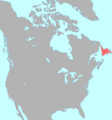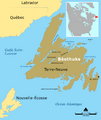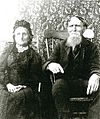Beothuk facts for kids
The Beothuk (pronounced Bee-AH-thuk) were a group of Indigenous people who lived on the island of Newfoundland. Their unique culture began to form around the year 1500 CE. These people were the most recent group to live in Newfoundland, following ancestors who first moved there from Labrador around 1 AD. Before the Beothuk, there were three earlier groups, each living on the island for about 500 years.
Contents
About the Beothuk
The Beothuk lived all over Newfoundland, especially in the areas known as Notre Dame Bay and Bonavista Bay. We don't know exactly how many Beothuk people there were when Europeans first arrived. Some experts believe there might have been only 500 to 700 people. They lived in small, independent family groups, usually with 30 to 55 people in each.
Like many other groups who hunted and gathered food, the Beothuk likely had leaders for their groups, but probably not formal "chiefs" like in some other societies. They lived in special cone-shaped homes called mamateeks. These homes were made by arranging poles in a circle, tying them at the top, and covering them with birch bark. For winter, these homes were made stronger. Inside, the floors were dug out to create hollows for sleeping, and a fireplace was built in the middle.
The "Red Indians"
Every spring, the Beothuk used red ochre to paint their bodies. They also painted their homes, canoes, weapons, tools, and musical instruments. Because of this practice, Europeans started calling them "Red Indians." Using ochre was very important to their culture. They did this decorating during a yearly spring celebration that lasted several days. It showed who belonged to their tribe. For example, painting newborn children was a way to welcome them into the tribe. If someone was not allowed to wear ochre, it was a form of punishment.
Food and Hunting
The main foods for the Beothuk were caribou, salmon, and seals. They also gathered other animals and plants. The Beothuk moved with the seasons to follow their main food sources. In the fall, they built long fences, sometimes 30 to 40 miles (48 to 64 km) long. These fences were used to guide migrating caribou towards hunters armed with bows and arrows.
The Beothuk also made a type of pudding from tree sap and the dried yolk of great auk eggs. They saved extra food to use during the winter. They also trapped animals for their fur and used the skins to make warm clothing. They wore the fur side of the clothing against their skin to help trap air and keep them warm.
Canoes and Burials
Beothuk canoes were made from caribou or seal skin. The front part of the canoe was made strong with spruce bark. These canoes looked a bit like kayaks. They were about 15 feet (4.6 m) long and 2.5 feet (0.76 m) wide. They were big enough to carry children, dogs, and belongings.
The Beothuk had special ways of burying their dead. They would wrap bodies in birch bark and bury them in quiet, out-of-the-way places. Sometimes, a shallow grave was covered with a pile of rocks. Other times, they would place the body on a wooden platform or in a burial box, with the knees folded. The people who were still alive would place offerings at the burial sites. These offerings included small statues, necklaces, and copies of tools, to go with the dead.
Images for kids
-
Newfoundland, historic home of the Beothuk
-
Statue of Shanawdithit in Boyd's Cove
See also
 In Spanish: Beothuk para niños
In Spanish: Beothuk para niños








